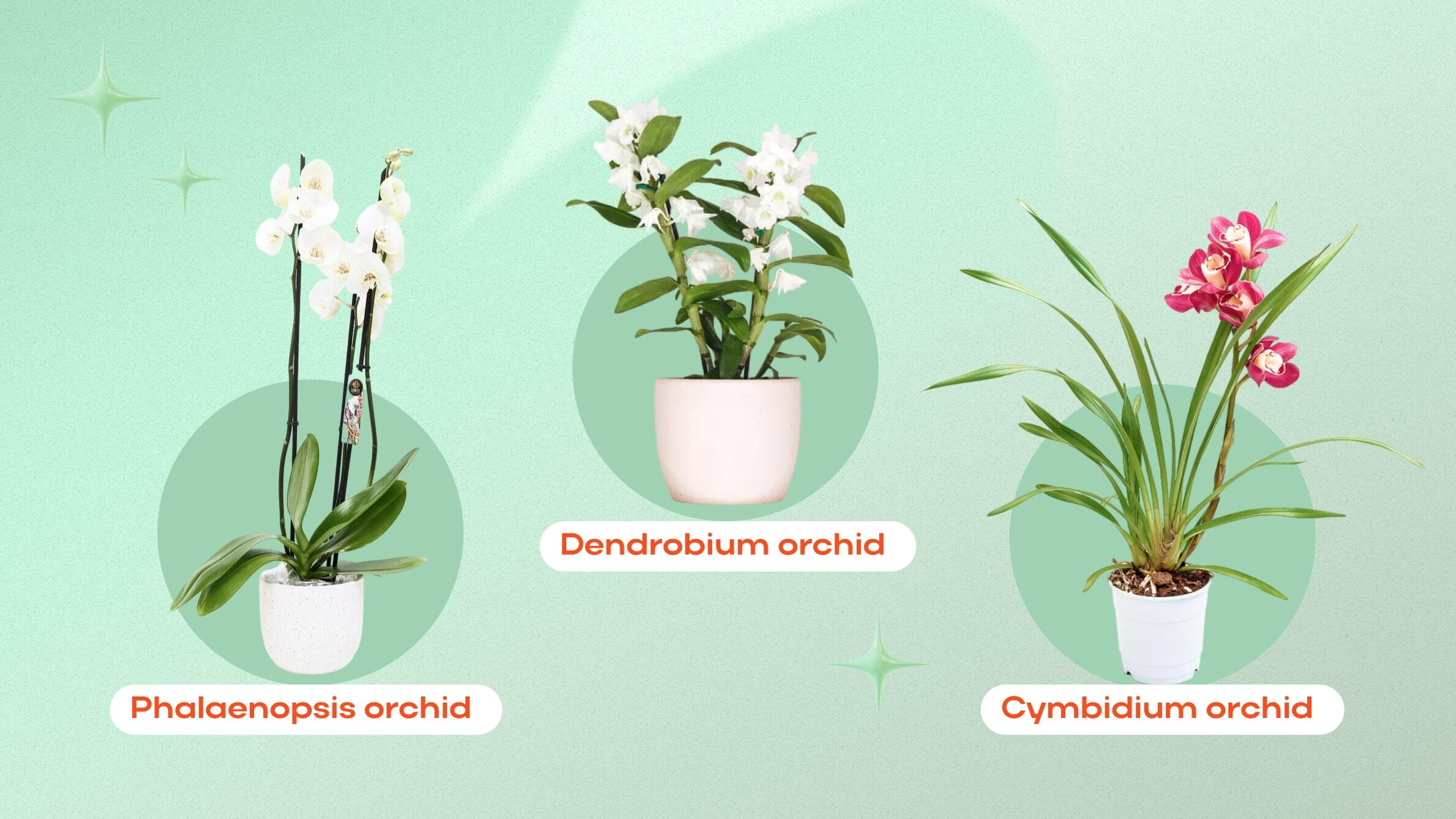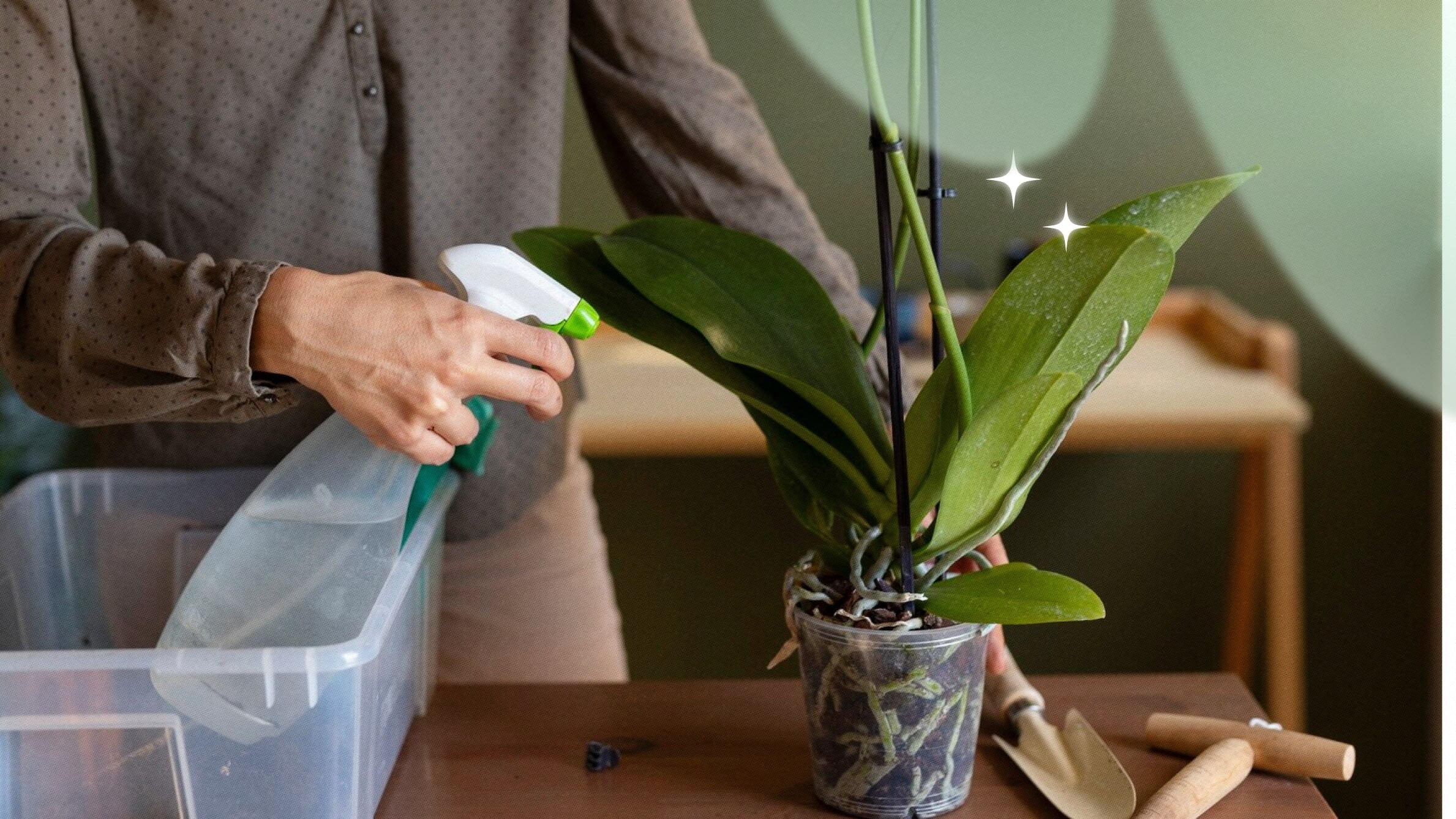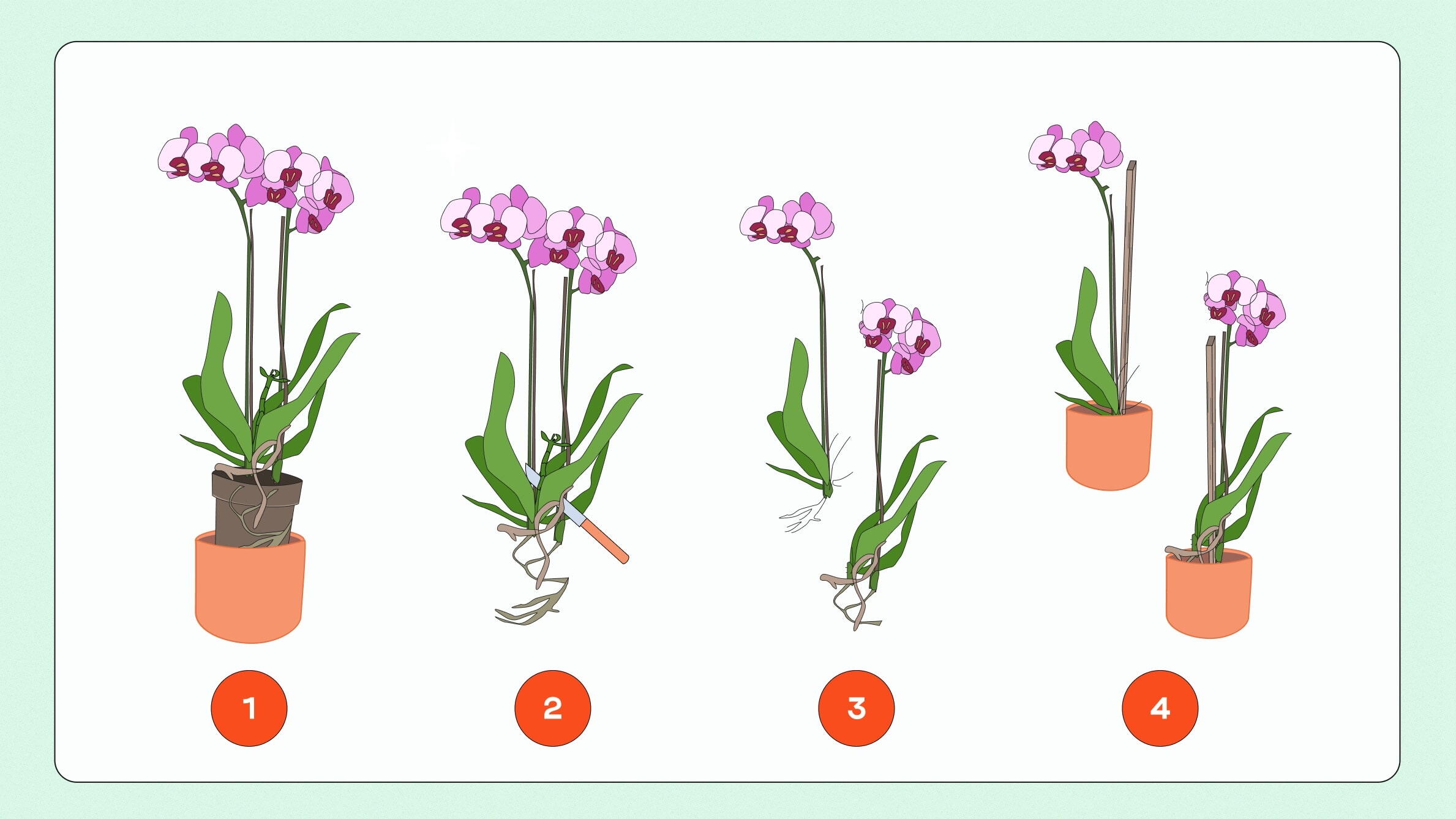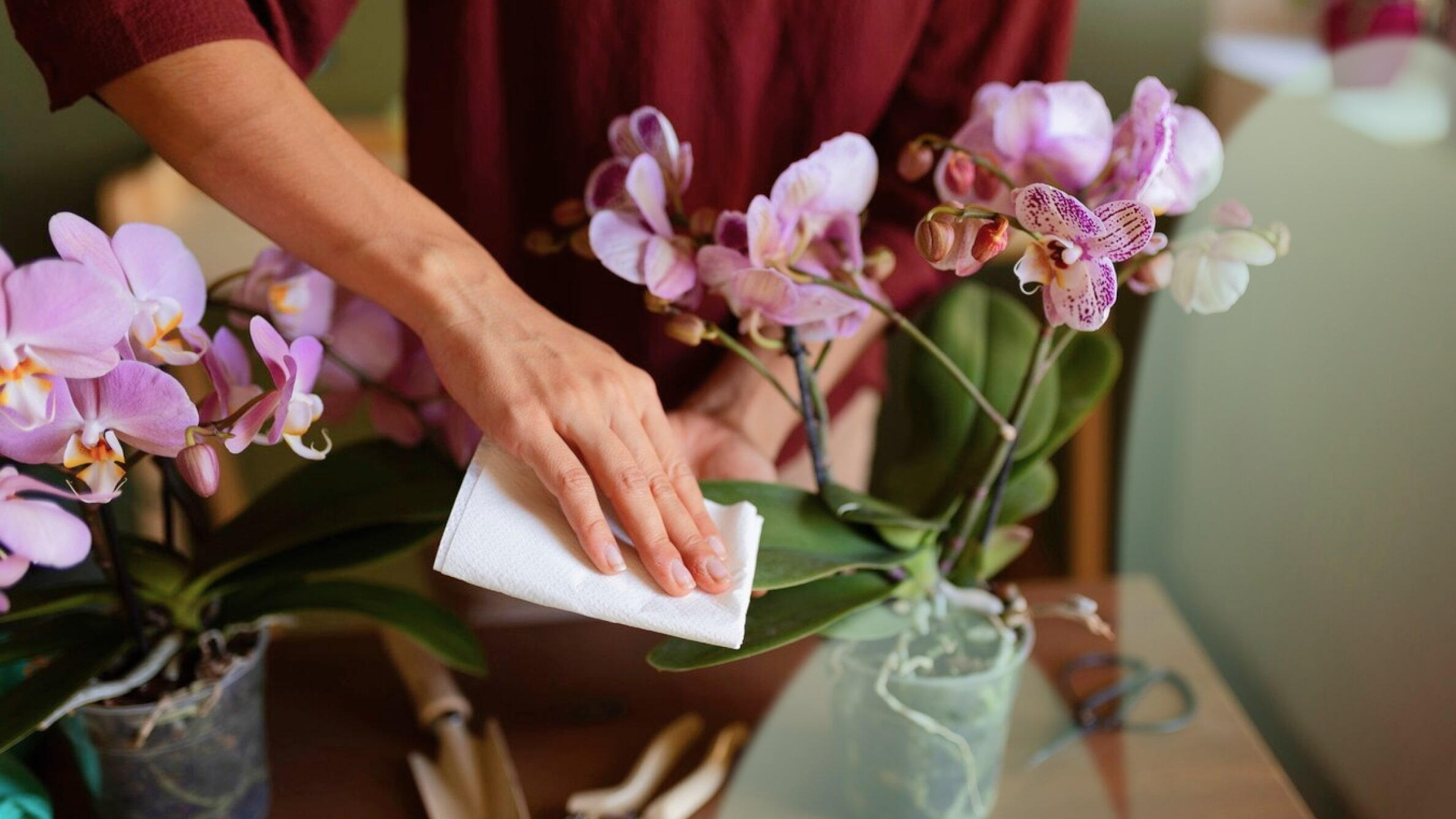
Elegant and graceful, the orchid presents an opportunity to cultivate a lush, tropical haven within any interior space. While this enchanting plant may require careful tending, its delicate blossoms and myriad hues offer rich rewards to those who nurture it. In today's piece, we share an in-depth guide to orchid care for beginners, providing you with the knowledge to cultivate these refined flowers and ensure they thrive, bringing joy and beauty to your indoor environment.

What is important to know about orchids
When it comes to answering the question 'How to take care of an orchid?' the key is to replicate conditions that mimic its natural environment as accurately as possible. In their natural habitat, these flowers prosper in the temperate climates of Asia, Central and South America. They may either be terrestrial, rooted in the soil, or epiphytic, which cling to trees or rocks and develop aerial roots.
It's essential to examine the growing requirements beforehand when selecting a variety to suit your environment. Additionally, thoroughly inspect the plant for any signs of disease or damage before committing to the purchase. With optimal care, it can enjoy a lengthy lifespan, extending beyond 15 years.
Orchid types for home growing

In the UK, an impressive array of orchid species is available, each flaunting distinctive traits and stunning appearances. Let’s discover charming plant varieties perfectly suited for indoor cultivation.
Phalaenopsis orchid
Phalaenopsis, commonly known as the Moth orchid, boasts distinctive moth-shaped flowers (from which its name is derived), along with juicy, elliptic leaves. Proper Phalaenopsis orchid care entails maintaining a warm temperature (above 16-18°C), ensuring the plant receives ample, filtered light, and providing sufficient humidity. To promote thriving growth, consider situating it in kitchens or bathrooms near windows that face east.
Dendrobium orchid
Dendrobium, often referred to as the Bamboo orchid, is identifiable by its slender foliage and petite blooms arranged neatly along stems emerging from sturdy canes. Proper care for Dendrobium orchids involves ensuring temperatures remain above 16°C and providing a moderate level of humidity. It's essential to keep these plants cool and dry during the rest period (from autumn through spring), ideally placing them on the porch or windowsill.
Cymbidium orchid
Cymbidium or the Boat orchid, showcases vibrant flowers with multiple lobes, adorned with a colourful column and lips. Adequate cymbidium orchid care is pivotal for preserving its beauty and health: this species thrives in cooler conditions, requiring a minimum temperature of 10°C, coupled with ample, filtered light to flourish.

Paphiopedilum orchid
Paphiopedilum, commonly referred to as the Slipper orchid, has a preference for moderate temperatures, thriving best when kept above 13°C; varieties with spotted foliage tend to favour slightly warmer conditions. This plant is suited to low light conditions but requires ample humidity to flourish. During winter, it's advisable to move them to a cool, brightly lit area.
Vanda Orchid
In its natural environment, this species typically suspends from trees or rocky surfaces, flourishing without the need for soil. Providing proper care for a Vanda orchid involves placing it in warm settings with ample indirect sunlight and sustaining high humidity levels. During the summer, it can benefit from being placed outdoors.
Cambria orchid
These striking hybrids, adorned with vividly coloured, spotted flowers, are an ideal option for novice orchid enthusiasts. They thrive in warm temperatures above 18˚C and enjoy bright, indirect light. Place Cambrias in rooms free from drafts and water them weekly for optimal growth.
Orchid care at home

Lighting and watering
When it comes to how to care for an orchid, ensuring proper lighting and watering are essential considerations. These plants thrive when exposed to diffused sunlight, a condition attained by allowing rays to bounce off a surface or filtering them through another object. Aim for about six hours of light daily to encourage flowering and maintain overall plant health.
During the warmer months when orchids are in their growth phase, it's recommended to water them twice a week. However, as temperatures cool down, you can scale back to a weekly watering schedule. Utilise either purified or freshly boiled and cooled tap water at room temperature; pour it gradually until it seeps out from the drainage apertures in the pot. Ensure the soil has the opportunity to thoroughly dry between waterings.
Temperature and Humidity
Typically, orchids do well in temperatures ranging from 10°C to 32°C, accompanied by humidity levels roughly between 40% and 70%. The optimal temperature for the period of active growth is 22-24°C, along with fairly high humidity. However, precise requirements may vary based on the specific variety.
Soil
An integral part of orchid plant care involves selecting the appropriate soil mix. Orchids flourish in soil blends containing components such as bark, perlite, peat, sphagnum moss, or similar substrates, which offer both rapid drainage and moisture retention.
Fertiliser
During their prime growth period, typically in spring and summer, orchids benefit from regular feeding with a 10-10-10 or 20-20-20 fertiliser formulated specifically for them. Adhere to the guidelines provided on the label, applying the feed once a week. Once flowering begins, consider pausing or reducing fertilisation until the plant enters the next cycle of active growth.
Where to place the orchid
Create the ideal setting for your home orchid by situating it in a draft-free room with stable temperatures, while avoiding direct sunlight and exposure to fruits. Optimal lighting conditions can be achieved by placing the plant near south or east-facing windows.
Pots for orchids

The preferred option is transparent plastic pots with perforations or slots for drainage. They facilitate the examination of the planting substrate and monitoring of its moisture levels, thereby preventing waterlogging and maintaining optimal root health. Select a pot that fits your plant properly and sterilise it to ensure protection against fungal growth, viral infections, and insect infestations.

Types of watering an orchid

Watering orchids can be approached through various methods, each with its own merits. It's advisable to either combine these techniques or select the most suitable one based on the specific preferences of your variety. Whatever option you choose, remember: these plants are particularly averse to overwatering.
Submerging an orchid in water

Place the flower pot in a deep container and carefully pour water until it reaches the junction between the roots and the stem. Allow the orchid to absorb moisture for about 15 to 20 minutes, then remove the pot from the water and let it drain.
Using an ice cube for orchid care

Put three ice cubes atop the potting medium, ensuring they don't touch the roots or the foliage. The brief chilling shouldn't harm your plant as the ice melts swiftly. To gauge if this watering is adequate, inspect the roots or leaves of your orchid. Silvery roots signal thirst, while bright green roots indicate ample moisture; if the plant appears overwatered, its leaves will be wrinkled, dull, and wilted.
Simple watering of an orchid
You can simplify the care of orchid plants by following a traditional watering method. Give your plant about a quarter glass of water once a week — this straightforward approach ensures success, even for a beginner. Adjust the amount depending on the temperature — slightly more in hotter conditions, and a bit less in cooler ones.
Planting and repotting orchids in pots

1. Extract the plant from its current pot and gently detach its roots from the old soil mixture.
2. If any of the old planting mix adheres stubbornly to the roots, soak them in water.
3. Utilising a sterilised cutting tool, excise any roots that are dead or injured.
4. Transplant your orchid into a slightly larger pot, ensuring the roots are submerged in fresh soil.

5. Given that the roots won't be firmly established in the medium yet, consider using a stake to support the orchid if needed, ensuring it stays upright.
6. Water the orchid and moisten the surrounding soil.
Pruning Orchids

A key aspect of encouraging future blossoms and stimulating growth in orchids is through proper pruning. As the blooming season of your plant concludes and the flowers begin to wither or drop, it marks the opportune moment for the procedure.
- Employing a sanitised tool, carefully trim any withered leaves, roots, or tissues, ensuring to make angled cuts. Proceed cautiously and be delicate: even a minor cut can lead to the deterioration of an otherwise healthy leaf.
- When pruning for the first time on a healthy stem, trim it immediately above the node where the initial flower bloomed. If the stem is unhealthy or has already been pruned before, it's best to cut about 2.5 centimetres above its base.
Propagating Orchids
Orchid seeds are notoriously difficult to grow due to their demanding requirements. Instead, these plants are commonly propagated through division.

- Remove the plant from its vessel; consider dampening the soil to aid in extraction.
- Inspect the roots carefully, and eliminate any portions that show signs of damage or decay, such as being black, soggy, or overly slender.
- Separate the roots and stems. If manual division proves challenging, utilise a sanitised, razor-sharp cutting instrument.
- Replant each section in new potting soil, adding stakes for support where necessary, and ensure they are adequately hydrated.
Orchid care after flowering

Once the blooms have faded, trim the old flower spike close to the base using a sanitised, sharp blade to ward off infections. Additionally, consider transferring your plant to a better-suited pot with a lightweight, porous growing mix.
Pests of orchids

Orchids generally face few pest problems, yet they can still be susceptible to various common pests like aphids, spider mites, fungus gnats, scale insects, and mealybugs. These nuisances can typically be controlled by gently removing them, rinsing them with water, or applying insecticidal soap.
Orchid care tips for beginners

Mastering indoor orchid care may appear quite challenging, but with some knowledge and dedication, beginners can excel in nurturing these exquisite plants. Let's address some key questions to guide you.
What to do if flowering stems and leaves turn yellow
Yellowing of leaves might occur as a result of excessive watering and subsequent root rot. To prevent this issue, allow the potting soil to fully dry between waterings or consider repotting your orchid, ensuring the removal of any damaged roots. Yellowing of flowering stems could indicate overwatering, sunburn caused by intense light, inadequate nutrient supply, or fungal infection. Yet, it's typical for ageing flowering stems to brown once the blooms have withered away.
What to do if an orchid drops its flowers
If flower buds fall prematurely, it indicates stress in the plant, stemming from either excessive or inadequate watering, fluctuating temperatures, drafts, exposure to nearby chemical pollutants, or proximity to plants or fruits emitting ethylene gas.
What to do if orchid leaves wilt
If the foliage is drooping, it might indicate a lack of water, low humidity, or insufficient light. Withered leaves are a frequent issue seen in orchids, often signalling dehydration within the plant cells. Check the roots to ascertain why the plant lacks water: if healthy, consider underwatering; if not, consider root loss, potentially from excessive watering, potting mix decay, or inadequate establishment after recent repotting.
How to get orchids to bloom

Each year, an orchid is expected to bloom at least once, although the blooming cycles vary among species. It displays blooms typically for an average period spanning two to four months.
Ensuring rebloom primarily involves providing appropriate lighting, adequate temperature, humidity level, nutrients, and growth substrate. However, certain types such as Phalaenopsis can be induced into blooming by reducing temperatures for several nights.
A prevalent cause for your orchid's failure to rebloom could be insufficient access to sunlight. Check the leaves: in low light, they darken and stiffen, while in very bright light, they may show pink or red edges. If the plant lacks sufficient light, consider using supplemental lighting sources.













